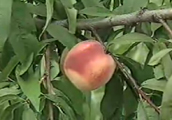Integrated Pest Management / Peaches

Streaming Video - High resolution | Low resolution | RealPlayer Help
Summary
Fruit pests are a pain, but pesticide fans aren't exactly legion, either. It may sound like a novel concept to try to reduce both, but Agriculture and Agri-Food Canada scientists have been doing just that for over 50 years. The technology is called Integrated Pest Management, or IPM, and it works by pitting pests against their enemies, or trapping them with false promises of sex. Pesticides are used only as a last resort, when conditions warrant. Since its beginnings in Nova Scotia's apple orchards half a century ago, IPM is now used in fruit crops across the country. Ontario's peach growers, for instance, have access to IPM technology that can reduce pesticide use by a whopping 75 per cent.
Transcript of Video
Jay Ingram
Insects are a fruit farmer's worst enemy and across Canada, the weapon of choice against them has long been chemical pesticides. Those weapons have their drawbacks and limitations, so some farmers in Ontario are resorting to trickery and deceit to keep the bugs off their fields.
Jay Ingram (voice over)
Do you think that reducing pesticides in agriculture is a new trend? Would it surprise you to learn that the approach has been practised in Canada for 50 years?
David Pree
In Canada it began in Nova Scotia in their apple industry at the end of World War II when they were more or less pushed into developing a cheaper way of growing fruit, and they developed what they called a reduced pesticide program and they developed a system of taking advantage of beneficial insects, mites, what have you, and at the same time reducing pesticide use in their orchards. The program was cheaper than a completely insecticidal or chemical control program and it was adapted by the growers there and used - and it's still in use there. Modifications of it are ongoing now.
Jay Ingram
Here at Vineland in Ontario, an Integrated Pest Management program, or IPM, for peaches was developed and introduced in the mid 70's. The program initially cut pesticide use in half, but recent advances make it possible to do away with a whopping 75 percent of the pesticides that would normally be used.
David Pree
One of key things about IPM and integrated controls and that sort of thing is the use of multiple approaches to controlling a pest species, particularly those which we have to have high levels of control, like direct pests of fruit - like the Oriental Fruit Moth.
Jay Ingram
The fruit moth's larval, or caterpillar, stage is the real culprit. Keeping them from being born is the strategy. The female moth communicates her mating readiness with pheromones, chemical cues that we can't smell, but which the male fruit moths find irresistible. Science has turned the moth's allure into its undoing. Scent glands are removed from the female moths. From these, pheromones are extracted and collected. Based on the samples, scientists can synthesize the pheromones that are particular to any given species. When the moths are about to mate, pheromone laced dispensers are placed in the orchard, permeating the air with the scent of female fruit moth. The males are ready to mate, but can't locate the females in the saturated cloud of pheromone. Mating is disrupted, and most of the moths die before they can reproduce. Fewer destructive caterpillars to ruin the fruit means less pesticide spraying.
David Pree
The advantage of using a pheromone... using pheromones is that we can eliminate an additional three-quarters of the pesticides that we would normally apply for oriental fruit moth.
Jay Ingram
Aside from the fruit moth there are secondary pests in orchards.
David Pree
There are good mites and bad mites. The European red mite is a little Red guy who feeds on foliage, then there are the predacious mites ... and it feeds on the European red mite. It does much better under a system where we're not using a lot of insecticide.
Jay Ingram
Less pesticide means that more of the beneficial insects survive. There's also a better chance that insects won't develop resistance – so that when pesticide is necessary, it still works on the target bugs. In an ongoing effort to keep one step ahead of the pests, Agriculture and Agri-Food Canada scientists continue to investigate new possibilities for biological control.
Bruce Broadbent
The future of IPM, I'm hoping, will include more biological controls such as the fungus that I'm working with. It's a natural insect disease. It only takes a single spore from the fungus to land on the cuticle, or the skin, of the insect and then it germinates and penetrates through the cuticle inside the insect and the fungus grows and basically fills the body of the insect, killing it in the process.
Jay Ingram
The fungus, though lethal to bugs, is safe for other animals and the environment. Still being studied, it may be an approach that's integrated into IPM programs in the future.
David Pree
I think that there's abundant evidence that tells us that we can't rely on one technique or one approach. So we need to truly integrate more approaches into our field program. There's a lot of basic science still to be done before we can say 'Ah! We've got a long-term sustainable system and we can all go home'. These ecosystems continually evolve as well. So they're ongoing... the research is ongoing.
Earth Tones is produced in co-operation with Agriculture and Agri-Food Canada.






